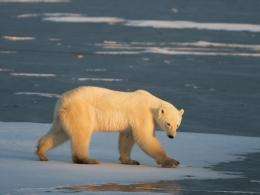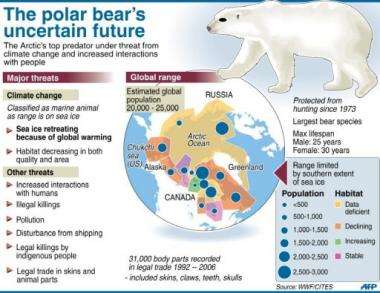US designates 'critical' polar bear habitat in Arctic

The US government designated "critical habitat" for polar bears who live on Alaska's disappearing sea ice, a move that could impact new oil and gas drilling projects in the Arctic.
The Fish and Wildlife Service set aside 187,000 square miles (484,000 square kilometers) off Alaska as the threatened bears' habitat, which means any project that could impact the animals' way of life must undergo careful review.
"This critical habitat designation enables us to work with federal partners to ensure their actions within its boundaries do not harm polar bear populations," said Tom Strickland, Assistant Secretary for Fish and Wildlife and Parks.
"Nevertheless, the greatest threat to the polar bear is the melting of its sea ice habitat caused by human-induced climate change. We will continue to work toward comprehensive strategies for the long-term survival of this iconic species."
The move falls short of barring any drilling or other activity in the area, but "identifies geographic areas containing features considered essential for the conservation of the bear that require special management or protection."
US environmental advocates earlier this month warned that polar bear habitats could be disrupted if oil companies eager to exploit the Arctic for fuel were to experience an accidental spill like the BP gusher in the Gulf of Mexico.
The Fish and Wildlife Service acknowledged that the designation, which includes swaths of the Beaufort and Chukchi Seas off northern Alaska, "encompass(es) areas where oil and gas exploration activities are known to occur."
Any activity there would now have to undergo a review to "identify ways to implement these actions consistent with species conservation," the statement said.

"This applies to oil and gas development activities, as well as any other activity within the range of the polar bear that may have an adverse affect on the species."
The United States has classified the polar bear as "threatened," but not endangered, due to the struggles it endures because the sea ice on which it lives and hunts is melting due to climate change.
The US government is considering opening the Chukchi Sea, a body of water off the coast of Alaska that is shared with Russia, to drilling but is reviewing leases awarded in 2008 after a lawsuit by indigenous people and green groups contended that the government does not have enough facts about how drilling will impact the environment.
Companies like Royal Dutch Shell want to begin drilling in the coming months, once winter ice begins to break up, and are submitting proposals to show they can meet tougher new government regulations.
The US Geological Survey said in 2008 that within the Arctic circle there are 90 billion barrels of oil and vast quantities of natural gas waiting to be tapped, most of it offshore.
(c) 2010 AFP















